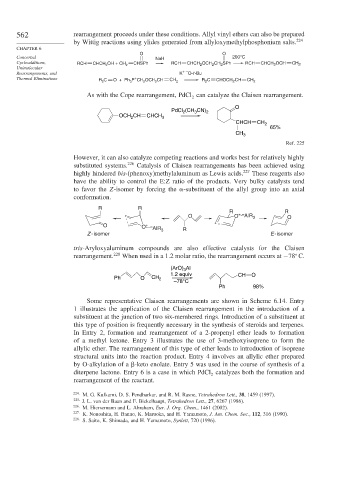Page 588 - Advanced Organic Chemistry Part B - Reactions & Synthesis
P. 588
562 rearrangement proceeds under these conditions. Allyl vinyl ethers can also be prepared
by Wittig reactions using ylides generated from allyloxymethylphosphonium salts. 224
CHAPTER 6
O O
Concerted NaH 200°C
Cycloadditions, RCH CHCH 2 OH + CH 2 CHSPh RCH CHCH 2 OCH 2 CH 2 SPh RCH CHCH 2 OCH CH 2
Unimolecular
Rearrangements, and K + – O-t -Bu
+
Thermal Eliminations R 2 C O + Ph 3 P CH 2 OCH 2 CH CH 2 R 2 C CHOCH 2 CH CH 2
As with the Cope rearrangement, PdCl can catalyze the Claisen rearrangement.
2
O
PdCl (CH CN) 2
3
2
OCH CH CHCH 3
2
CHCH CH 2
65%
CH 3
Ref. 225
However, it can also catalyze competing reactions and works best for relatively highly
substituted systems. 226 Catalysis of Claisen rearrangements has been achieved using
highly hindered bis-(phenoxy)methylaluminum as Lewis acids. 227 These reagents also
have the ability to control the E:Z ratio of the products. Very bulky catalysts tend
to favor the Z-isomer by forcing the -substituent of the allyl group into an axial
conformation.
R R
R R
O O + – AlR 3 O
O O + – AlR
Z - isomer 3 R E - isomer
tris-Aryloxyaluminum compounds are also effective catalysts for the Claisen
rearrangement. 228 When used in a 1.2 molar ratio, the rearrangement occurs at −78 C.
(ArO) Al
3
1.2 equiv CH O
Ph O CH 2
–78°C
Ph 98%
Some representative Claisen rearrangements are shown in Scheme 6.14. Entry
1 illustrates the application of the Claisen rearrangement in the introduction of a
substituent at the junction of two six-membered rings. Introduction of a substituent at
this type of position is frequently necessary in the synthesis of steroids and terpenes.
In Entry 2, formation and rearrangement of a 2-propenyl ether leads to formation
of a methyl ketone. Entry 3 illustrates the use of 3-methoxyisoprene to form the
allylic ether. The rearrangement of this type of ether leads to introduction of isoprene
structural units into the reaction product. Entry 4 involves an allylic ether prepared
by O-alkylation of a -keto enolate. Entry 5 was used in the course of synthesis of a
diterpene lactone. Entry 6 is a case in which PdCl catalyzes both the formation and
2
rearrangement of the reactant.
224 M. G. Kulkarni, D. S. Pendharkar, and R. M. Rasne, Tetrahedron Lett., 38, 1459 (1997).
225
J. L. van der Baan and F. Bickelhaupt, Tetrahedron Lett., 27, 6267 (1986).
226
M. Hiersemann and L. Abraham, Eur. J. Org. Chem., 1461 (2002).
227 K. Nonoshita, H. Banno, K. Maruoka, and H. Yamamoto, J. Am. Chem. Soc., 112, 316 (1990).
228
S. Saito, K. Shimada, and H. Yamamoto, Synlett, 720 (1996).

